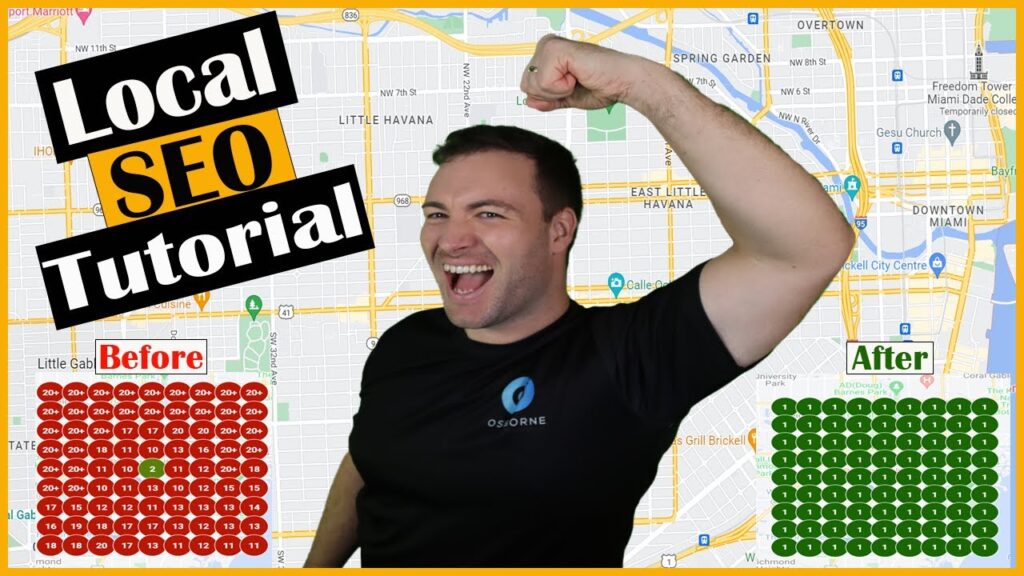As I sat down to write this post, I couldn't help but think back to my early days in digital marketing when I was still looking for the right SEO strategy. It was a daunting maze filled with technical jargon that made my head spin! I remember my first client - a small landscaping business struggling to get noticed online. After a long and bumpy road, we finally crafted the perfect local SEO tutorial, and I want to share that journey with you all. If you're feeling lost in the local SEO jungle, you've come to the right place!
TL;DR: In this guide, I’ll share practical steps for mastering local SEO, from optimizing your Google Business Profile to analyzing your competitors and planning your SEO strategy - perfect for small businesses!
Table of Contents
The Local SEO Fundamentals
Understand The Significance Of Local SEO For Small Businesses
Local SEO is crucial for small businesses looking to thrive in their communities. Imagine you're a shopper searching for a nearby coffee shop. You likely pull out your phone and type "coffee near me." This is where local SEO comes into play. If your business isn't optimized for local searches, it may never appear in those results.
As I learned from Ron's tutorial at Osborne Digital Marketing, a well-strategized local SEO approach can significantly raise your visibility. It helps potential customers discover you when they're actively looking for services or products in their area. This active search means higher chances of conversion, as these users have intent. Don't you want to be the one they find?
- A strong local SEO presence puts you on the digital map.
- It helps you connect with local customers.
- It builds trust and reliability as you improve your online reputation.
An Overview Of Google Business Profiles And Their Impact
One key takeaway from the tutorial was the importance of Google Business Profiles (GBP). These profiles are free listings you can create on Google that display essential information about your business, such as your address, phone number, hours, and reviews from customers. Think of it as your digital storefront that appears right where potential customers are searching.
Ron emphasized that every small business needs an accurate and optimized GBP. If you offer lawn care services, ensure that your primary category reflects this. Don't confuse potential leads by listing yourself as a general landscaper when your main focus is lawn care.
Regularly reviewing your GBP is essential. You want to attract new reviews as they boost your credibility. Let's remember the example of the landscaping company Divine, located in Miami. They had a five-star rating based on just four reviews. This shows a lack of customer engagement. More reviews mean increased visibility and trust.
Common Pitfalls Small Businesses Face In Local SEO
Many small businesses fall into the trap of neglecting their local SEO efforts. Here are a few pitfalls they often encounter:
- Inconsistent NAP: This stands for Name, Address, and Phone Number. Consistency across your online listings is vital. If your phone number differs on Yelp compared to your website, it leads to confusion.
- Ignoring SEO Basics: Some may overlook basic on-page SEO aspects, such as optimizing title tags or meta descriptions. These elements can heavily impact search visibility.
- Neglecting User Experience: Load speed is a critical factor. Websites that load slowly risk losing visitors. Ron pointed out that if your site takes more than three seconds to load, you're likely losing potential customers.
One particularly insightful part of the session involved competitor analysis. By observing how competitors rank higher, you can tailor your strategies. Ron used Divine as an example, comparing it to competitors who had numerous reviews. Simply having a high rating isn't enough; you need volume to build trust.
Furthermore, building citations - references from platforms like Google Maps - gives your business credibility. The goal should be to have around one hundred citations for optimal verification by search engines. After all, do you want search engines to trust you? I know I would.
Incorporating all these elements into a coherent local SEO strategy can feel overwhelming at first. But, just like maintaining a garden, with attention and care, it pays off in the long run. It's not a one-and-done task; it requires regular updates. Local SEO isn't a sprint; it's a marathon that leads to improved visibility and customer engagement over time.
What Do You Need To Optimize Your Google Business Profile
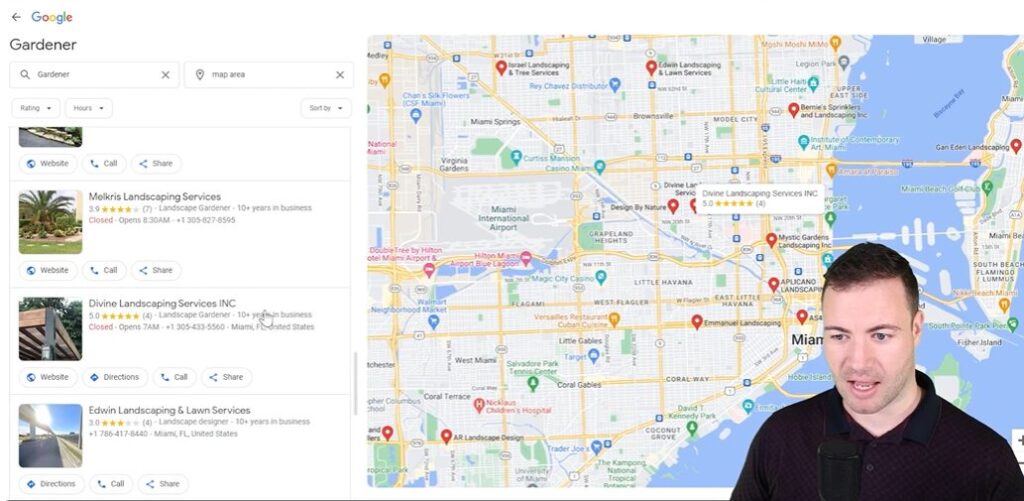
Setting up a Google Business Profile (GBP) might sound daunting, but I promise it’s easier than you think. With the right steps, you can make your business stand out in local search results. Let's break it down step-by-step.
1. Step-By-Step Guide To Setting Up A Google Business Profile
First, you'll need to visit the Google Business website. Here, you can get started by clicking on the "Manage now" button. But what do you need to do next? Here’s a simple checklist to follow:
- Create an account: If you don’t have a Google account, you’ll need to set one up. This will give you access to your profile.
- Add your business name: Make sure it’s exactly how customers know it.
- Choose a category: This is vital! Picking the correct category helps Google show your business to relevant customers. Let’s say you run a landscaping business; you'd select "Landscaping" and perhaps something like "Lawn Care." This is essential for visibility.
- Enter your location: If you serve customers at a physical location, include your address. If you don't have a storefront, you can define the areas you service.
- Contact details: Add your phone number and website. It’s a must for customers to reach you easily.
- Verification: Google will send you a postcard to verify your business. This step is crucial, so pay attention!
Following these steps can ensure you lay a strong foundation for your GBP.
2. Key Elements To Include: Categories, Photos, And Reviews
Now, it's not just about setting it up. You’ve got to optimize for best results. Here are key elements you can't afford to ignore:
- Categories: As I mentioned, your primary category is essential. If your secondary services exist, list them too. It helps improve your visibility.
- Photos: A picture speaks a thousand words! High-quality photos showcasing your products or services will make a lasting impression. Think of it this way: would you trust a bakery that doesn't show off its delightful cakes?
- Reviews: Encouraging customers to leave reviews is vital. Positive feedback builds credibility and boosts your rankings. Always respond to reviews - both good and bad - to show you value customer feedback.
I often say, “Treat your GBP like a living entity.” It needs care and attention.
3. How To Consistently Update And Maintain Your Profile
Okay, we’ve set it up and added elements. But how do we keep it fresh? Regular updates are key!
- Set reminders: I suggest marking your calendar to review your profile at least once a month.
- Update regularly: This includes adding new photos, updating your hours during holidays, or adding new services. Even changing your business description can engage your audience anew.
- Monitor reviews: Make it a habit to check for new reviews. A simple "thank you" to positive reviews or a professional response to criticism goes a long way.
Remember, Google loves activity! A maintained profile can significantly enhance your visibility.
“A well-optimized Google Business Profile is not just a convenience; it’s a necessity for local businesses.” – Ron from Osborne Digital Marketing
By engaging in this process, you're ensuring that your Google Business Profile remains a powerful tool for connecting with potential customers. Each update can lead to a new opportunity, which is something we all want for our businesses.
In summary, optimizing your Google Business Profile involves setting it up correctly, incorporating essential elements, and maintaining it consistently. This trifecta is your recipe for success in local SEO.
Analyzing Competitors: A Crucial Step In Your Strategy
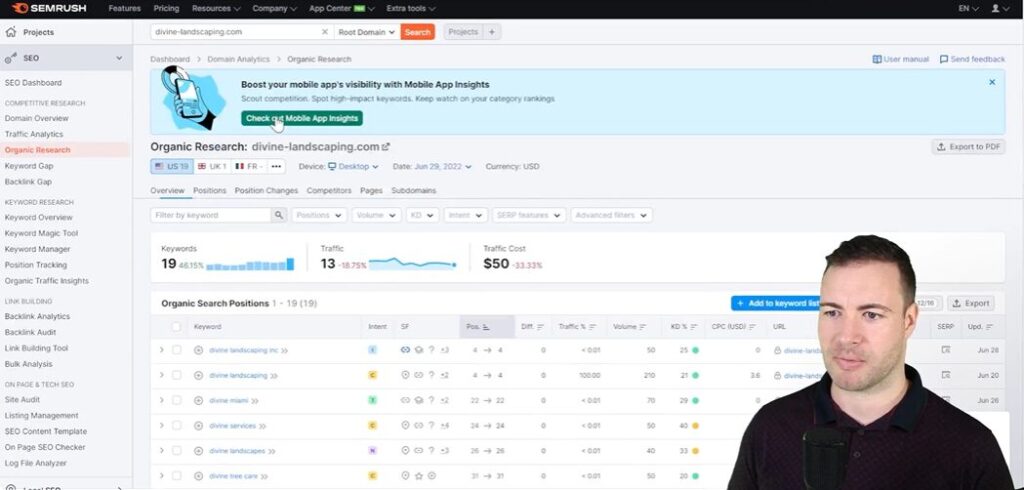
1. How To Conduct A Thorough Competitor Analysis
To start, competitor analysis is like treasure hunting - only, instead of gold coins, you're digging up insights about those vying for the same customers. It's essential to know what your competitors are doing. I often suggest breaking it down into these steps:
- Identify Key Competitors: Look for businesses that offer similar products or services. Who ranks higher in Google for your target keywords?
- Analyze Their Online Presence: Tools like
SEMrushorAhrefscan provide valuable insights into authority scores, organic traffic, and backlinks. This data is pivotal. - Review Google Business Profiles: Take a peek at the GBP of competitors. Are they getting more reviews? What categories are they listed under? You can learn a lot from their positioning.
- Content Analysis: Evaluate the content they create. Are they targeting specific keywords effectively? What topics resonate with their audience?
- Engagement Tactics: Observe how they interact with customers. Do they respond promptly to reviews? Engagement can massively influence trust and reputation.
By taking these steps, we can paint a clear picture of competitor strategies and tailor our approach effectively. Remember, it’s never about imitation but rather learning and evolving.
2. Why Understanding Your Competitors Can Boost Your Own Rankings
You might wonder, "Why bother examining competitors?" The answer lies in the reality that ranking on Google is a race; knowledge is your best running shoe. When we analyze what works for competing brands, we uncover tactics that can enhance our rankings too.
- Spotting Stronger Keywords: If competitors rank for certain keywords, they probably have high-quality content. We can adapt that knowledge to target similar terms.
- Backlink Opportunities: By examining their backlinks, we might find sites willing to link to us too. This is invaluable for credibility and ranking.
- Review Volume: A look at how many reviews competitors get can highlight our need to boost our customer feedback efforts.
- Market Position: Are they carving a niche successfully? Identifying their advantages can inspire us to find our unique strengths.
In essence, understanding our competitors opens doors for improvements that might otherwise fly under the radar. Isn’t that worth the effort?
3. Identifying Gaps And Opportunities In Your Competitor's Strategies
When we dig deeper into competitor strategies, we often come across gaps - areas they haven't fully explored. The beauty is that these gaps are golden opportunities for us. Here’s how I’ve found them in the past:
- Under-Targeted Keywords: If your competitor ignores certain keywords or topics, seize the chance to fill that void by creating targeted content.
- Weak Content Areas: Look at their content. Are they lacking engaging visuals or clear calls-to-action? You can provide what they're missing.
- Engagement Gaps: If they neglect their social media engagement, stepping up in that arena can instantly set us apart.
- Service Deficiencies: Perhaps they lack specific services. We can tailor our offerings to meet those unfulfilled needs.
Through identifying these gaps, we have the power to craft a strategy that not only meets current market demands but also sets us apart from our competitors. So, why wait? Let’s get excited about the potential!
“Understanding your competition is as important as delivering quality service.” – Ronald Osborne
Competitor analysis is more than just checking what others are doing; it’s about using that insight to drive our strategy forward. So let’s dive in, analyze, adapt, and advance!
Crafting Your Local SEO Strategy: Actionable Steps

In the digital age, establishing a robust local SEO strategy is not just beneficial; it's essential. I’ve learned a great deal about how local businesses can improve their visibility through my readings and experiences. With the right approach, you can connect better with your community. Let's dive into some actionable steps.
Establishing Clear Objectives
The first step in crafting your local SEO strategy is to establish clear objectives. Ask yourself, what are you trying to achieve? Are you looking to increase foot traffic to your store? Or perhaps you want to enhance online bookings? Clear objectives will serve as the foundation for your efforts. They guide your actions and help you stay focused.
- Identify your primary goal: Whether it's increasing review volume, improving website traffic, or boosting online sales, knowing your aim is crucial.
- Define your target audience: Understand who you want to reach, their needs, and how local searches influence them.
- Formulate your unique selling proposition (USP): This differentiates you from competitors and clarifies your value to potential customers.
Setting KPI Metrics
Next, it's time to translate those objectives into specific, measurable outcomes. This is where Key Performance Indicators (KPIs) come into play. Setting the right KPIs allows you to track your progress effectively.
For example:
- Track the number of new reviews on Google Business Profile (GBP) each month.
- Monitor website traffic from local searches using tools like Google Analytics.
- Measure rankings for specific keywords, such as "landscaping in Miami," to gauge visibility improvements.
These metrics provide a scorecard of your performance. If you find you're not hitting your targets, it's a sign to reevaluate your strategy. Just as Ron from Osborne Digital Marketing highlights, *regularly reviewing your data ensures you're on the right track and can adapt quickly if necessary*.
Creating A Timeline
Having clear objectives and KPIs is excellent, but without a timeline, you're merely setting goals without a plan to achieve them. Creating a timeline helps organize your SEO efforts. Here’s how to break it down:
- Set short-term and long-term goals: What do you want to achieve within the next month? And what about the next quarter?
- Allocate time for each task: For instance, if you plan to enhance your GBP, dedicate a specific week solely to that effort.
- Include review periods: Regular check-ins, perhaps monthly, allow you to assess what’s working and what isn’t.
Establishing deadlines not only keeps you motivated but also ensures accountability. How often do we set vague goals without a timeline, only to let them slip? Setting clear dates helps keep your local SEO strategy on track!
By establishing clear objectives, setting relevant KPIs, and creating a reasonable timeline, we can construct a robust local SEO strategy that effectively enhances our online presence. With consistency and effort, we will vastly improve our rankings and visibility.
Local SEO is an ongoing process. It requires regular review and adaptation of strategies. There’s so much to explore and implement, and the rewards are well worth the effort.
Local Citations And Backlink Building: Why They Matter
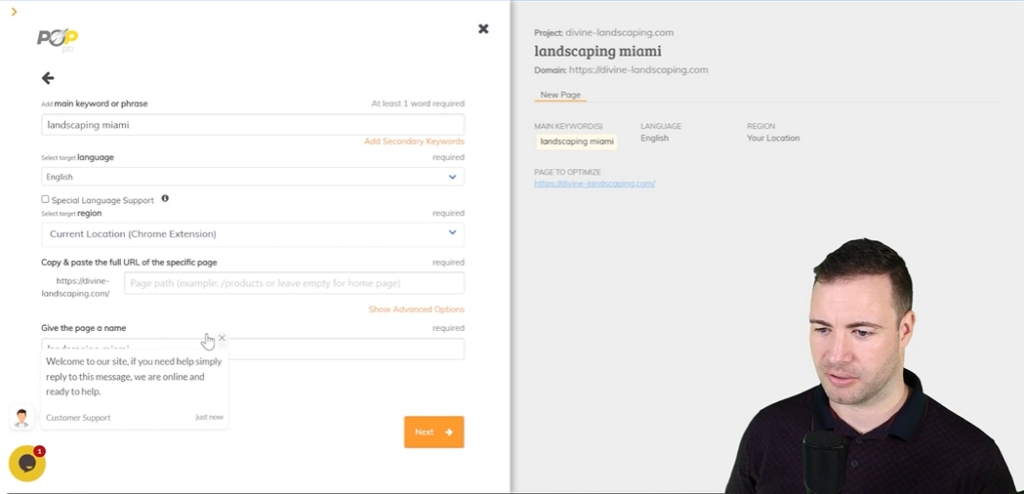
When we talk more about local SEO tutorial, one term frequently pops up - local citations. So, what are they? Local citations refer to online mentions of your business’s name, address, and phone number (often called NAP). Think of it like having a business card online. Just like a card, building local citations help people find and know about your business.
But why are they so crucial for local SEO? Well, citations act as a confirmation of your business’s existence from third-party sources. This boosts your credibility in the eyes of search engines like Google. When Google sees your business listed in various reputable sources, it takes this as an affirmation of your authenticity. It’s like when we recommend a restaurant; our friends are likely to trust it more. This trust is essential for ranking better in local searches!
Strategies For Building High-Quality Local Citations
Now that we know what local citations are and their importance, let’s dive into some effective strategies for building high-quality local citations.
- Start with Directories: List your business on major online directories like Google Business Profile, Yelp, and Yellow Pages. Make sure to fill out all fields accurately. Incomplete profiles can hurt your credibility.
- Consistency is Key: Always maintain consistency in your NAP. If your address is listed as “1234 Example St, Apt 5" in one place, it must not be “1234 Example Street” in another. Inconsistent information can confuse search engines and affect your rankings.
- Focus on Local Relevance: Aim to be listed in niche-specific directories. For instance, if you run a plumbing business, consider directories relevant to contractors or home services. Local relevance enhances your chances of being found by your target customers.
- Utilize Social Media: Don’t underestimate the power of social media. Platforms such as Facebook or Instagram can serve as citations if your business is accurately represented. Make it a point to engage with customers and update your profiles regularly.
By employing these strategies, we can help ensure that our local citations are not just numerous but also high-quality, boosting our local SEO.
Tips For Earning Backlinks Effectively
Now let’s explore another aspect that complements local citations - backlinking. Think of backlinks as votes of confidence from other websites. When reputable sites link back to yours, it signals to search engines that your content is valuable. How can we earn those valuable backlinks?
- Content Creation: Create engaging, informative, and original content. People are likely to link back to content that is thorough and insightful. The more value you provide, the more likely others will refer to your site.
- Networking: Cultivating relationships with local businesses can lead to backlinking opportunities. Consider reaching out to collaborate or share insights. As Ron mentioned in his tutorial, “Benchmark against your competition.” See where competitors are earning their backlinks and explore those avenues.
- Guest Blogging: Write guest posts for reputable blogs within your industry. Include links back to your site in your author bio or within the content when appropriate. It not only benefits you but also firms up your authority in your niche.
- Press Releases: If you have noteworthy news, consider issuing a press release. Major publications could pick up the news, and in turn, link back to your website.
With a proactive approach to earning backlinks, you can significantly enhance your local SEO. Following these pointers can feel like an uphill climb, but progress is vital. Each local citation and backlink adds to your digital existence!
Monitoring And Adjusting Your Strategy: The Final Piece
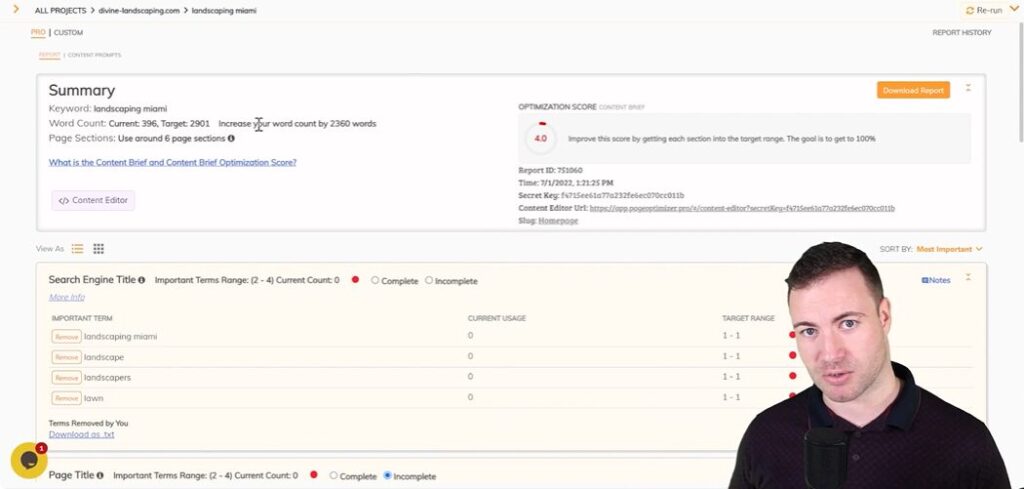
So, we've come to a pivotal stage in our SEO journey: monitoring and adjusting our strategies. Why is this so essential? Well, without evaluation, how do we even know what’s working? Just like a gardener checks the soil and sun exposure to ensure plants thrive, we need to keep a close eye on our SEO efforts.
Tools For Tracking Your SEO Progress And Performance
When it comes to tracking SEO progress, the right tools can make all the difference. Here are some essential tools I recommend:
- Google Analytics: This is a must-have. It gives you insights into traffic sources, user behavior, and conversion rates. Understanding where your traffic comes from can help you gauge the effectiveness of your strategies.
- SEMrush: I recently dived into using SEMrush for a business case study. With this tool, I could evaluate a company's authority score, organic search traffic, and backlinks. For instance, one company I looked at had only a few backlinks, which affected their visibility.
- Google Search Console: This tool offers direct insights into how Google sees your site. It shows you which queries bring traffic, highlights site errors, and helps you optimize based on performance metrics.
- Ahrefs: If you want to analyze your competitors’ backlink strategies or find keyword opportunities, Ahrefs can be a game changer.
Each of these tools provides critical information. Understanding metrics like organic traffic, bounce rates, and backlink counts is like having a treasure map. You need it to find the hidden gold!
How To Pivot Your Strategies Based On Performance Metrics
Now that we have tools in place, adjusting our strategies is where things really get interesting.
- Identify Key Performance Indicators (KPIs): What areas matter most? Is it site traffic, conversions, or engagement? Choose your KPIs wisely; they will guide you.
- Regular Reviews: I recommend setting weekly or monthly reviews. Check how your strategies are performing. Are users engaging with your content? If something isn’t working, it’s time to pivot.
- Testing and Tweaking: A/B testing is your friend! Experiment with different titles, meta descriptions, or even layouts to see what resonates more with your audience.
- Learn From Competitors: You can always learn something new from those who are winning. Are they using keywords more effectively? Do they have more backlinks? Make observations and apply them to your strategies.
- Google Algorithm Updates: Regular updates can affect your rankings. Sometimes a small tweak can either elevate your site or push it down. Staying informed means you can quickly adapt to changes.
- Emerging Technologies: With the rise of voice search and smart assistants, how we optimize our content needs an update. Are you optimizing for voice queries?
- Customer Preferences: Consumer behavior is always shifting. Keeping an ear to the ground lets you cater your content in a way that speaks directly to your audience.
Conclusion: Your Roadmap To Local SEO Success
As we wrap up this local SEO tutorial, let’s take a moment to reflect on what we've learned together. It’s a lot, but it's incredibly impactful. From the importance of optimizing your Google Business Profile (GBP) to understanding local search algorithms, I hope you now see how each component works to enhance your online presence. One thing that really strikes me is how crucial accurate information is. When I learned that being specific in the primary category of your GBP can make a significant difference, it clicked. Are we really conveying who we are?
The session led by Ron from Osborne Digital Marketing showcases the need to regularly review our business profiles and solicit those precious customer reviews. But, let’s be honest, it’s not all about you - and that’s the beauty of it! It involves understanding your competitors, learning what they do right, and applying those strategies to your business. The example of Divine illustrated this perfectly. Even with its five-star rating, it struggled in search results because it did not foster enough customer interaction. This is something we must all prioritize. Be proactive in gathering feedback. It matters.
We also tackled technical aspects, such as page load speed and mobile performance, which often feels like a puzzle. I used to wonder, why does website performance matter so much? After seeing Ron demonstrate the performance test, I realized that users are quick to leave a site that takes too long to load. It’s not just a minor inconvenience; it can cost you potential customers. So, are your web pages swift enough to keep those visitors engaged? Aim for high scores in core web vitals.
Furthermore, we uncovered the necessity of schema markup, citations, and local content creation. By enhancing our website with schema markup, we’re effectively speaking the search engine’s language, facilitating better understanding and visibility in search results. Also, maintaining accurate citations from platforms like Yelp or Google Maps builds credibility, which is non-negotiable in local SEO.
With all this information laid out, you might feel overwhelmed. I know I did at first. But here’s where the power of actionable steps comes into play. Set priorities for your local SEO initiatives. Begin by optimizing your GBP, then dive into competitor analysis, and don't forget to monitor your website's performance. Start with small changes and build over time. Remember, each action can lead to significant results.
For those of you eager to learn more, I encourage you to explore resources like Google Analytics and Google Search Console. They provide rich insights about your website's performance, offering the data necessary to refine your strategies further. Additionally, consider visiting blogs and tutorials that focus specifically on local SEO. They are invaluable in keeping your knowledge fresh and updated with trends and algorithms.
Your journey to local SEO success doesn’t end here. It’s a continuous process filled with adjustments and adaptations. Always remember: achieving visibility is a marathon, not a sprint. If you take away one thing from this discussion, let it be this: strive to improve continuously. Follow the checklist provided, benchmark against competitors, and always aim higher. Success will follow.
